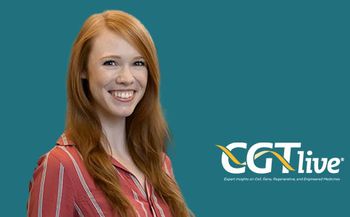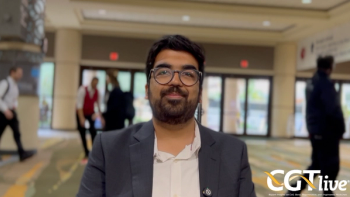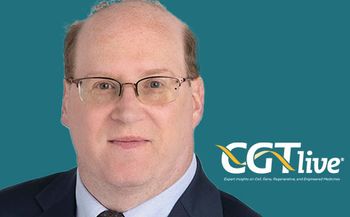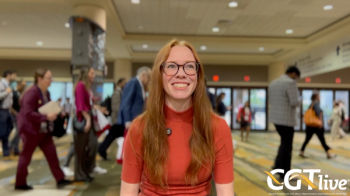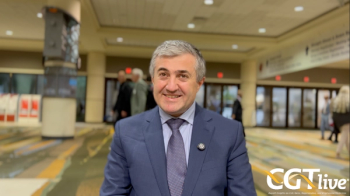
ASH 2020: CAR T-Cell Therapy Updates
Exciting new and ongoing developments in chimeric antigen receptor (CAR) T-cell therapies were covered at the 62nd American Society of Hematology (ASH) annual meeting.
CAR T-Cell Therapies Old and New: Cilta-Cel Wows in Multiple Myeloma; Axi-Cel Shows 44% OS at 4 Years in LBCL
Chimeric antigen receptor (CAR) T-cell therapy is no longer the new kid on the block at the 62nd American Society of Hematology (ASH) annual meeting, but results for this groundbreaking treatment still excite as the technology moves beyond acute lymphoblastic leukemia and different forms of lymphoma to multiple myeloma.
The virtual presentation December 5, 2020, featured phase 1b/2 results for ciltacabtagene autoleucel (cilta-cel), Janssen’s investigational B-cell maturation antigen (BCMA) CAR T-cell treatment for patients whose multiple myeloma has progressed after as many as 6 treatments.
Cilta-cel produced an overall response rate (ORR) of 97% and a stringent response rate of 67% with a median follow-up time of 12.4 months, according to data presented by Deepu Madduri, MD, of The Tisch Cancer Institute at Mount Sinai, New York, and the principal investigator of CARTITUDE-1.1
Median duration of response and progression-free survival (PFS) were not reached.
Patients with multiple myeloma have a poor prognosis if their disease progresses after 3 treatments, Madduri said, with a typical overall survival (OS) of less than 6 months. But in CARTITUDE-1, cilta-cel has produced deep responses in these patients. “I think a one-time treatment to give these deep, durable responses is what we need for our myeloma patients. It’s one step closer to getting a cure.”
In an interview, Madduri cited no correlation between the number of prior treatments and patient response. “We had a median of 6 prior lines of therapy—it ranged anywhere from 3 to 18 prior lines of therapy.”
Results from the open-label study presented at ASH covered 97 patients; median age was 61 years and 58.8% were male. Data showed the following:
- 12-month PFS was 77% (95% CI, 66%-84%), and the 12-month OS rate was 89% (95% CI, 80%-94%).
- Patients typically responded to cilta-cel within the first month, and manufacturing of the treatment was successful for all patients.
- 93% of patients achieved minimal residual disease, an important marker of response.
- In the combined results, the most common hematologic adverse events (AEs) were neutropenia (96%), anemia (81%), thrombocytopenia (79%), leukopenia (62%), and lymphopenia (53%).
Cytokine release syndrome (CRS), a common AE of CAR T-cell treatment, was seen in 95% of patients and lasted for an average of 4 days (range, 1-97), with 99% of cases resolving within 14 days. Of CRS events, 95% (n = 87) were grade 1 or 2, 3% (n = 3) were grade 3, and 1 patient experienced a grade 4 event. The statement from Janssen reported 1 “grade 5” AE, or death from CRS; Madduri told the session that overall, 6 people have died due to AEs from treatment.
The median onset of CRS was 7 days after infusion, with 89% not seeing CRS until day 4. This could demonstrate the potential for cilta-cel to be given in an outpatient setting. Asked during the session to offer a possible reason why CRS starts later with cilta-cel than other CAR T-cell treatments, Madduri said, “We think this is probably related to cell expansion, because it expands a little bit later than some of the other therapies.”
Neurotoxicity was seen in 21% of patients, with 10% (n = 10) having neurotoxicity of grade 3 or higher, including 1 death. Immune effector cell–associated neurotoxicity syndrome was
seen in 16 patients and typically occurred alongside CRS. Other cognitive effects were seen in 12 patients; these generally occurred after CRS had resolved.
Madduri noted that clinicians have become more adept at managing toxicities. “We tend to give tocilizumab much earlier now, not necessarily waiting until grade 2 CRS—so I feel these patients are managed easily with the supportive care that we have,” she said.
Long-term Results for Axi-Cel
The long-term promise of CAR T-cell therapy was seen in 4-year results for axicabtagene ciloleucel (axi-cel) in adult patients with refractory large B-cell lymphoma (LBCL). Sold as Yescarta (Kite Pharma/Gilead), axi-cel was the first CAR T-cell therapy approved for this indication and the second overall.2
Kite Pharma announced long-term follow-up data for the ZUMA-1 trial; among 101 patients at least 4 years past a single infusion of axi-cel (median follow-up, 51.1 months), a Kaplan-Meier estimate of OS was 44%. The 101 patients who had refractory LBCL were among 111 patients enrolled in the original phase 2 ZUMA-1 trial. These patients had a median period of less than 2 months from leukapheresis to complete response. Also, no treatment-related secondary malignancies have been reported.
“With close to half of patients still alive after a single infusion of axicabtagene ciloleucel, we are transforming the way relapsed or refractory large B-cell lymphoma can be treated,” Frederick L. Locke, MD, said in a statement. Locke was the co-lead investigator of ZUMA-1 and is the vice chair of the Department of Blood and Marrow Transplant and Cellular Immunotherapy at Moffitt Cancer Center in Tampa, Florida. “I continue to see these patients in the clinic, and this overall survival data confirms the durability of CAR T-cell therapy in a patient population that previously exhausted all viable treatment options,” he said.
Of note, the investigators reported results from 21 patients with blood samples at the 3-year mark; for 14 patients (67%), the CAR-marked cells were still detectable. Normal B cells were also found in 91% of evaluable patients, which investigators said suggests that the effects of treatment last beyond the persistence of functional CAR T cells.
Long-term results with axi-cel come as Kite Pharma/Gilead face possible competition from lisocabtagene maraleucel (liso-cel), an investigational therapy from Bristol Myers Squibb. Liso-cel would treat patients with diffuse LBCL, but it involves a different manufacturing process that could lessen the effects of CRS when the patients receive therapy. The FDA missed a target date for action due to delays inspecting a manufacturing facility, but approval is still possible before the end of 2020.
Results from the OUTREACH study presented December 5, 2020, also suggest that liso-cel can safely be administered in an outpatient setting,3 and an abstract for results scheduled to be presented Sunday suggests substantial savings when liso-cel is administered in the outpatient setting compared with the inpatient setting.4
References
1. Madduri D, Berdeja JG, Usmani SZ, et al. CARTITUDE-1: phase 1b/2 Study of ciltacabtagene autoleucel, a B-cell maturation antigen–directed chimeric antigen receptor T cell therapy, in relapsed/refractory multiple myeloma. Presented at: 62nd American Society of Hematology Annual Meeting and Exposition; December 5-8, 2020; Virtual. Accessed December 15, 2020. https://ash.confex.com/ash/2020/webprogram/Paper136307.html
2. Jacobson C, Locke FL, Ghobadi A, et al. Long-term survival and gradual recovery of B cells in patients with refractory large B cell lymphoma treated with axicabtagene ciloleucel (axi-cel). Presented at: 62nd American Society of Hematology Annual Meeting and Exposition; December 5-8, 2020; Virtual. Accessed December 15, 2020. https://ash.confex.com/ash/2020/webprogram/Paper134362.html
3. Godwin JE, Freytes CO, Maris M, et al. Outcomes of treatment with the chimeric antigen receptor (CAR) T cell therapy lisocabtagene maraleucel (liso-cel) in the nonuniversity setting: initial results from the Outreach study. Presented at: 62nd American Society of Hematology Annual Meeting and Exposition; December 5-8, 2020; Virtual. Accessed December 15, 2020. https://ash.confex.com/ash/2020/webprogram/Paper136640.html
4. Palomba ML, Jun MP, Garcia J, et al. Costs of postinfusion monitoring by site of care for patients with relapsed/refractory (R/R) large B-cell lymphoma (LBCL) who received third-line or later treatment with lisocabtagene maraleucel (liso-cel) in the Transcend NHL 001 and Outreach trials. Presented at: 62nd American Society of Hematology Annual Meeting and Exposition; December 5-8, 2020; Virtual. Accessed December 15, 2020.
Creating Personalized Immunotherapy in Large B-Cell Lymphoma
When the chimeric antigen receptor (CAR) T-cell therapy axicabtagene ciloleucel (axi-cel) works in large B-cell lymphoma (LBCL), the results can seem miraculous. But this expensive treatment does not work for about a quarter of patients who receive it, and researchers who presented results at the annual meeting of the American Society of Hematology (ASH) think they know why.
With CAR T-cell therapy, a patient’s T cells are removed and engineered in a manufacturing process to express a receptor that will target and kill cancer kills. These CAR T cells are then reinfused back into the patient, and it is typically clear within a month whether the treatment has worked.
Researchers led by Robbie G. Majzner, MD, of Stanford University School of Medicine wanted to find out what went wrong when CAR T-cell therapy didn’t take hold.1 They analyzed genetic samples from 51 patients who received axi-cel and learned that 25% of patients had tumors that lacked a functioning version of the protein CD58. In all but 1 of these patients, the treatment did not produce lasting effects.
The researchers then confirmed their findings in a mouse model that lacked CD58; the team tested 3 different CAR T-cell therapies in the mice, but none worked.
Are patients whose tumors lack CD58 out of luck? Perhaps not. The research team determined that CD58 helped activate the biological mechanisms that allowed the CAR T-cell therapy to kill cancer. So, the investigators added a different protein, CD2, the T-cell ligand for CD58, to the job of the missing protein.
CD2, the researchers wrote in their abstract, “plays both an adhesive role and a costimulatory role in T cells.” In a series of experiments, they noted that blocking CD2 greatly reduced cytokine production after CAR stimulation, but this can be a sign that treatment is not working.
Conversely, by modifying CAR T cells with the additional protein, the researchers were able to show in experiments with mice that the treatment can work without CD58. This approach could be tested in clinical trials within the next 2 years.
The results would be of interest to payers, who have tried to create CAR T payment structures that reimburse drug makers only when the treatment works. However, the significant administrative costs for institutions must be absorbed somewhere, and this has created access issues for patients without commercial coverage.
“Achieving an uptick of 20% to 25% in the complete response rate would really bring cures to a large number of additional patients,” Majzner said.2 “Ultimately, we could potentially screen patients for CD58 status and provide a more precision approach to this therapy.”
References
1. Majzner RG, Frank MJ, Mount C, et al. CD58 aberrations limit durable responses to CD19 CAR in large B cell lymphoma patients treated with axicabtagene ciloleucel but can be overcome through novel CAR engineering. Presented at: 62nd American Society of Hematology Annual Meeting and Exposition; December 5-8, 2020; Virtual. Accessed December 12, 2020.
2. Genome editing and cellular therapies show promise for treating blood disorders, cancers. News release. American Society of Hematology. December 5, 2020. Accessed December 5, 2020. https://www.hematology.org/newsroom/press-releases/2020/genome-editing-and-cellular-therapies-show-promise-for-treating-blood-disorders-cancers
Newsletter
Stay at the forefront of cutting-edge science with CGT—your direct line to expert insights, breakthrough data, and real-time coverage of the latest advancements in cell and gene therapy.

